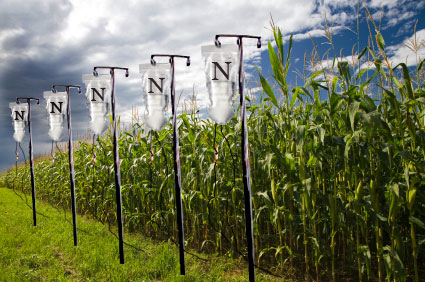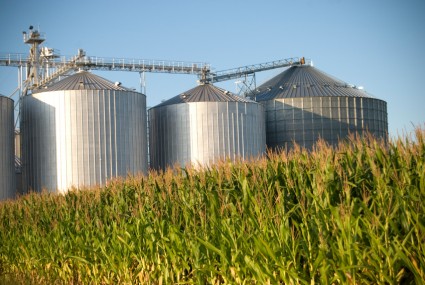 There are three things on which the mighty engine of U.S. agriculture depends: water, fuel, and synthetic nitrogen. Like water, nitrogen is elemental to life. It’s the essential building block of the plants we eat. Farmers remove it from the soil when they harvest the year’s crop, and they must replenish it for the following year’s.
There are three things on which the mighty engine of U.S. agriculture depends: water, fuel, and synthetic nitrogen. Like water, nitrogen is elemental to life. It’s the essential building block of the plants we eat. Farmers remove it from the soil when they harvest the year’s crop, and they must replenish it for the following year’s.
Compared with water and fuel, nitrogen is actually in one sense quite plentiful: it makes up about 80 percent of the air we breathe. Yet for all that ubiquity, it’s also in a sense scarce: its extremely strong chemical bond — it exists in the air in triple-bonded pairs of nitrogen known as N2 — makes it difficult for plants to use.
The N of the world as we know it
Less than 100 years ago, we learned — in the process of perfecting bomb-making technology — how to create readily available nitrogen on a vast scale. The introduction of mass-produced synthetic nitrogen fertilizer revolutionized agriculture, freeing farmers from the burdens of nitrogen fixation and allowing them to grow more food than ever before. Synthetic nitrogen revolutionized society, too: the explosion in crop yields that it helped drive made food cheaper and more plentiful than ever, setting the stage for the 20th century’s population boom.
This series has explored how the annual cascade of synthetic nitrogen fertilizer isn’t just helping farmers grow tremendous quantities of food; it is also generating serious problems for soil quality, public health, the climate, and more. As my article on the geopolitics of our N dependency showed, the process of generating synthetic nitrogen requires massive amounts of increasingly scarce natural gas. (In China, the situation is even worse; that nation, the globe’s largest consumer of nitrogen, uses coal, a fuel source significantly dirtier than natural gas, to produce 70 percent of its N supply.)
And because of the physiology of plants and the pressure to maximize yields, farmers routinely over-apply nitrogen. According to Peter Vitousek, a professor of biology at Stanford and a leading scholar on the nitrogen cycle, under optimum conditions and using best practices, plants take up only “50 or at best 60 percent” of the nitrogen laid on by farmers. So if so much of their fertilizer is going to waste, why do farmers apply so much? Vitousek explained that plants take up different amounts of nitrogen at different points in the growing cycle. To ensure that crops have sufficient N when they need it most, farmers essentially have to over-apply.
Globally, “about two-thirds of the nearly $100 billion of nitrogen fertilizer spread on fields each year is wasted,” estimates The Economist. That’s a lot of cash down the drain and a lot of nitrogen bleeding out of fields in various forms, wreaking all manner of havoc: Exhibit A, the 8,000-square-mile dead zone that blooms every year in the Gulf of Mexico, as Krysta Hozyash covered in this series.
Infertile ground for techno-fixes
But what to do about this genuine N dilemma? Our food system has become reliant on an input that appears to be unsustainable at current levels of use, while our population is growing. How can we maintain a robust, plentiful, growing food supply while also using less synthetic N?
Encouragingly, that question is being asked more and more in policy and academic circles. Even the staunchest proponents of industrial-scale agriculture acknowledge the need to use synthetic N more efficiently. But to date government and agribusiness efforts to address the problem have focused on techno-fixes: for-profit efforts to preserve the current food system while making it more nitrogen-efficient. One such fix is seeds that are genetically modified to use nitrogen more efficiently. The U.S. seed giant Monsanto and the Israeli biotech firm Evogene are collaborating to identify genes that can “improve nitrogen use efficiency in corn, soybeans, canola and cotton,” the companies announced two years ago.
And last fall, the Economist breathlessly heralded seeds engineered for nitrogen-use efficiency as “the next green revolution.”
“Imagine,” the magazine wrote, “you could wave a magic wand and boost the yield of the world’s crops, cut their cost, use fewer-fossil fuels to grow them and reduce the pollution that results from farming. Imagine, too, that you could both eliminate some hunger and return some land to rain forest.”
The subject of all this wonder: a gene identified by Arcadia Biosciences in Davis, Calif., that, when spliced into corn or rice, might helps crops “flourish” despite limited access to N. Yet even The Economist rated the technology’s ultimate prospects for success in the field as a “mighty big if.” Arcadia’s seeds remain in the trial stage.
 Peter Vitousek, a professor of biology at Stanford and a leading ecologistI asked Stanford’s Vitousek what he thought about GMO technology as a serious strategy for reducing nitrogen use.
Peter Vitousek, a professor of biology at Stanford and a leading ecologistI asked Stanford’s Vitousek what he thought about GMO technology as a serious strategy for reducing nitrogen use.
“There may be something there, but honestly, I think I gains [in nitrogen-use efficiency] will be marginal,” he replied. He explained that transgenic plant-breeding technologies work well for things like pest resistance: if you can isolate a gene that kills insects and express it in a crop — as Monsanto did with a gene from the Bt bacteria — then you have a blockbuster.
But the process by which plants utilize nutrients is much more complex, and involves multiple genes working together, making it unlikely that a single gene could be a game changer. “Plants have been evolving for millions of years,” he said. “I doubt that plant breeders will be able to hit upon anything for nutrient utilization that nature already hasn’t tried.”
Plant breeders, he emphasized, are “likely playing at the margins” when it comes to nitrogen-use efficiency.
Another strategy is to push farmers to use best practices: align their N applications more closely with their crops’ needs, perform more soil testing, try applying a little less and see if yields hold steady, as Stephanie Ogburn summarized. But here, too, marginal results may be the most that can be hoped for.
According to Vitousek, such efforts can push nitrogen-use efficiency up to the 50 percent or 60 percent level, but not much beyond. In other words, even using best practices, our farm fields are doomed to leak away 40 percent of the N applied.
Eating and farming our way to sustainability
Like all the experts I talked to, Vitousek argued that real progress in solving our N problem can only come with fundamental changes in both our eating habits and farms’ growing practices.
Today, Americans consume an average of more than a half pound of meat per day each day. The livestock feed needed to generate all that meat — and our dairy and egg habits — consumes more than 40 percent [PDF] of our entire corn crop, by far the world’s largest. Today, U.S. farmers grow 42 percent of the globe’s corn, more than twice the level of their closest competitors, Chinese farmers. (That doesn’t count the rapidly growing amount of distillers grains, an industrial waste product from the corn-ethanol stream that ends up in livestock rations.)
Corn is our most nitrogen-intensive crop; and every year it blankets our best farmland. Moving away from animal-intensive diets, and restricting what meat we do eat to livestock in pasture-based systems, would greatly ease our need for synthetic N.
And just as consumers will have to break the meat habit, farmers have to change their ways, too. The corn-soy-corn rotation that holds sway in the Midwest is deeply ingrained (so to speak); it’s a tremendously productive system, underpinned by hundreds of millions of dollars in infrastructure. Think of all those vast grain elevators, concentrated-animal feedlot operations, and industrial-scale slaughterhouses, to speak nothing of billions in annual crop subsidies.
 Billions of dollars in profit for the meat and corn-processing industries rely on an ample supply of corn, and thus massive overuse of synthetic N. But if that inertia could be overcome — if new styles of agriculture could take root and flourish in farm-intensive areas like the Midwest — we could greatly decrease our reliance on synthetic N, Vitousek agreed.
Billions of dollars in profit for the meat and corn-processing industries rely on an ample supply of corn, and thus massive overuse of synthetic N. But if that inertia could be overcome — if new styles of agriculture could take root and flourish in farm-intensive areas like the Midwest — we could greatly decrease our reliance on synthetic N, Vitousek agreed.
In organic agriculture, crop rotation is de rigueur. Moreover, organic farmers apply no synthetic N, relying instead on organic N from animal manure and nitrogen-fixing legume cover crops. Where synthetic nitrogen provides a jolt of plant energy, organic nitrogen releases slowly — and is typically better matched to a plant’s hunger than is synthetic. And when farmers plant a fall cover crop like winter rye, the crop pulls up much of the excess nitrogen, keeping it in the field for the next spring’s planting, instead of letting it run off into springs or entering the atmosphere as climate-warming nitrous oxide.
“The principles of organic agriculture have a lot to say to us about maintaining nutrient balance in the soil and being able to sustain production in the long-term,” Vitousek said.
Vitousek stressed that he wasn’t preaching “fundamentalism” with regard to organic agriculture — the emphasis should be on minimizing agrichemicals like synthetic N, not eliminating them. He draw a parallel with integrated pest management (IPM), which views pesticides as merely one in suite of tools to control pests, not the only tool. “Integrated nutrient management, which draws tremendously on organic principles, is a crucial way forward,” he emphasized.
In the current agricultural/policy environment, “organic fundamentalism” seems like an unlikely problem to have to worry about — not when the USDA’s research head is worried about the “safety” of organically fertilized food — and even Vitousek’s vision of “integrated nutrient management” seems far-fetched. The idea that “organic can’t feed the world” has a stranglehold on public consciousness, thanks to million-dollar ad campaigns by biotechnology companies designed to muffle international research showing that world hunger would best be tackled with sustainable small-scale agriculture methods and by increasing access to the more-than-adequate world supply of calories.
In addition to eating much less meat and buying organic when possible, N-conscious citizens should prepare to involve themselves in what promises to be a bitterly contested farm-policy debate. The 2012 Farm Bill may seem impossibly distant, but the lobbying for the principles that will form its foundation has already begun. The goal must be to shift federal funds from supporting large-scale corn production through commodity subsidies, to well-structured conservation programs that reward organic-style production.
To get involved in that debate, keep an eye on the National Sustainable Agriculture Coalition, which will be pushing a progressive agenda.



